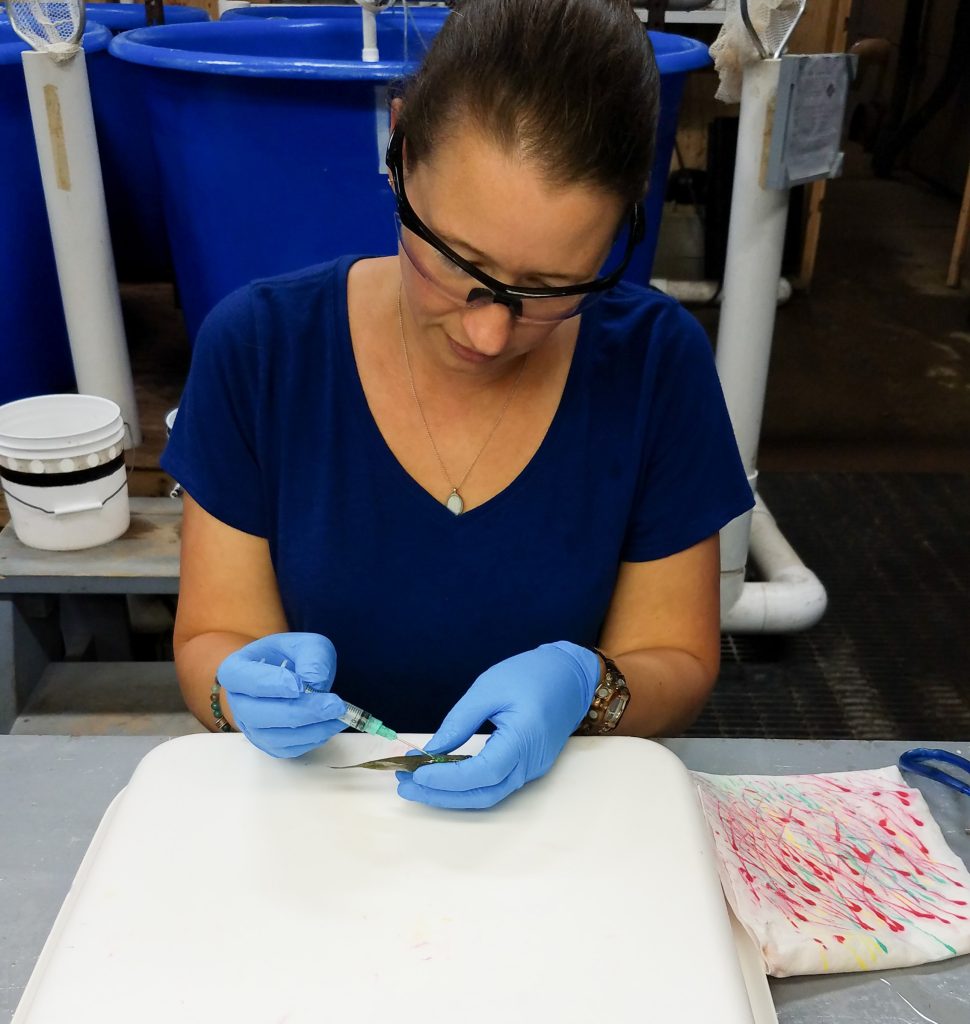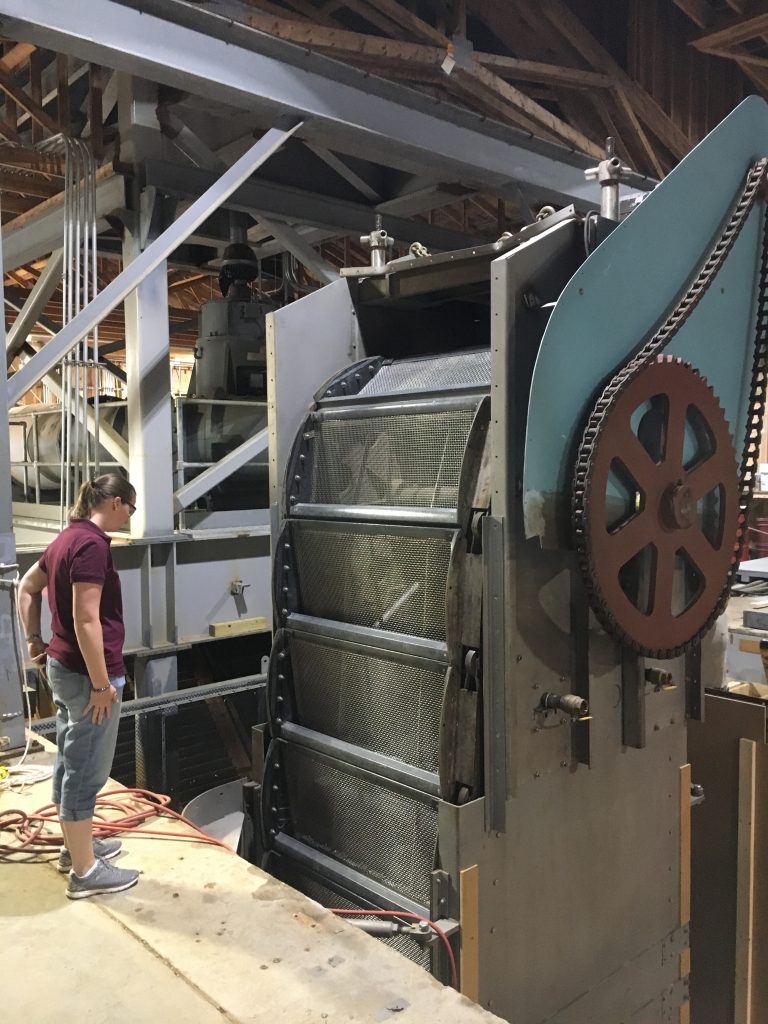Jenna Rackovan – Helping Fish Near Power Plants to Just Keep Swimming
Cleaner, greener electricity is imperative to meet the demands of a burgeoning population. Many power plants rely on vast quantities of water to cool their systems and maintain proper operation. But sucking up vast quantities of water can pose a risk for fish and other aquatic animals. Balancing the operational efficiency of power plant cooling systems with environmental protection requires a dedicated team of engineers and fisheries biologists. In their recent research, Jenna Rackovan and her colleagues at Alden Research Laboratory in Massachusetts optimise the use of travelling water screens for fish protection.
Cooling Power Plants with Water
Providing sufficient electricity to meet the demands of the growing human population while balancing environmental protection is a major concern for government organisations the world over. Power plants transform primary energy sources, such as coal, nuclear, natural gas, wind and solar energy, into electricity that is distributed to homes and businesses.
Some types of power stations, such as steam-electric plants, use water to cool their systems and keep them operating properly. Larger facilities often take in millions of litres a day, withdrawing this water from natural sources. Of course, natural water sources are shared with an array of aquatic creatures, which can follow the flow into an intake and become stuck on debris collection screens, or even pass through the cooling system. Both of these situations can lead to mortality of aquatic organisms.
In addition to their environmental value, many fish species that are affected by power plant water intake structures are commercially and recreationally valuable. The US Environmental Protection Agency (EPA) is keen to minimise the impacts of power plants to aquatic organisms. Rules made final in 2014 outline that water withdrawals exceeding a daily intake of 7.6 million litres must install the best technology available to reduce adverse environmental impacts.
This is where research scientists and engineers such as Jenna Rackovan and her colleagues at Alden Research Laboratory in Massachusetts are imperative. Achieving the best environmental outcomes first requires robust research to develop the right tools and technology.
In some of their recent work, Rackovan and her colleagues investigated whether intermittently operating and specially modified travelling water screens – large rotating structures that prevent fish and other aquatic organisms from becoming injured or killed – are sufficient to reduce fish mortality while increasing the efficiency of plant cooling system operation.

Cooling Systems: A Fishy Business
‘Fish-friendly’ travelling water screens are one of seven alternative technologies identified by the EPA for reducing mortality.
These fish-friendly screens include features specifically designed to prevent fish injury and mortality, such as collection buckets that minimise damaging water turbulence, screen materials that prevent skin injury and scale loss, continuous rotation of the screens, low-pressure spray washes, and fish return features with sufficient water flow and no large drops. Out of the available technologies, these fish-friendly travelling water screens are likely to be frequently used, because they can be easily retrofitted to existing water intake systems.
The general rule outlined by the EPA is to keep these travelling water screens rotating continuously, or nearly continuously. This minimises the length of time fish are held within the system, because they are only collected and returned to the source water while the screens rotate. However, continuous operation of these screens decreases the lifespan of the equipment, reduces operational efficiency, and increases the associated costs.
‘Our research focused on finding a balance between protecting fish and also attempting to find the best means of operation for the owners and operators of power plants,’ says Rackovan. To test whether running the screen intermittently is a viable optimisation option, she and her colleagues ran a series of tests with four common freshwater fish species – Golden Shiner, Bluegill, Largemouth Bass, and Common Carp – using a range of operational parameters.
Initially, they ran a preliminary evaluation in the lab within small test ‘flumes’ – channels of flowing water – to identify the parameters to take forward for large-scale testing. This included the speed at which fish approach the screens – or the ‘approach velocity’, and the duration that fish are held in the system while the screens are stationary. The conditions that produced moderate to high fish survival, of greater than 80%, were carried forward for large-scale testing.

Upscaled Screen Operation
Upscaling their evaluations to the large testing flume at the Alden Research Laboratory took a lot of dedication and hard work from the team to accomplish. The large test flume has walls of 3 metres high, a testing area of 24 metres long and 6 metres wide, and a holding facility with space for over 7000 fish.
The researchers found that approach velocity was the most important factor determining whether fish became trapped on the screen, the rate and severity of injuries and scale loss, and the probability of fish surviving the encounter. The probability of fish mortality increased as screens were kept stationary for longer and fish spent more time in the system. However, this effect was also strongly related to approach velocity.
The swimming abilities of fish – and therefore their ability to escape without becoming trapped on a screen – varies based on species and age, with each of the four species tested exhibiting different outcomes. Although smaller fish are weaker swimmers and thus more likely to become caught up in the water current, they may be able to hide in small pockets of low velocity within the system to avoid becoming trapped. In the field, more fish may be able to avoid the screens altogether, demonstrating the need for field studies.
Next Steps: Into the Field
Rackovan and her colleagues suggest that intermittent rotation of travelling water screens at power plants where approach velocities are low could be an acceptable technique to improve operational efficiency. In other circumstances, however, continuous rotation still may provide the best outcome for fish populations.
The researchers found that many different factors influence the outcome – for example, the location of the water intake relative to fish distribution, fish species, age, behaviour and health, intake and screen design features, approach velocity and stationary duration. Therefore, the research conducted by Alden and funded by the Electric Power Research Institute indicates that survival rates are site-specific and are best determined through direct testing.
SHARE
DOWNLOAD E-BOOK
REFERENCE
https://doi.org/10.33548/SCIENTIA814
MEET THE RESEARCHER

Jenna L. Rackovan
Alden Research Laboratory
Holden, MA
USA
Jenna L. Rackovan has spent her educational and professional career focusing on marine biology, and has worked for over a decade in fisheries. In her current position as a Fisheries Biologist at the Alden Research Laboratory in Massachusetts, her research focuses on fish passage and fish protection in systems such as fish bypasses, fish ladders, and travelling water screens, and studies of water quality, fish passage, and survival studies for hydroelectric facilities. The Alden Research Laboratory has been developing these technologies for nearly 50 years. Here, Rackovan’s research has included live fish testing in flumes, field evaluations, and hydraulic studies, which have used advanced engineering of design specifications to optimise design and operational criteria for these technologies. In addition to her research, Rackovan has shared her knowledge by mentoring and teaching undergraduate students, interns, and technicians.
CONTACT
E: jrackovan@aldenlab.com
W: https://www.verdantas.com/alden
KEY COLLABORATORS
Joe Zottoli, Stephen V. Amaral, and Brian McMahon – Alden Research Laboratory, Massachusetts
Jonathan Black – Electric Power Research Institute, California
FUNDING
Electric Power Research Institute
Consolidated Edison
FURTHER READING
JL Rackovan, J Zottoli, SV Amaral, J Black, B McMahon, Effect of Intermittent Traveling Water Screen Operation on Fish Survival, North American Journal of Fisheries Management, 2021, 41, 1714.

REPUBLISH OUR ARTICLES
We encourage all formats of sharing and republishing of our articles. Whether you want to host on your website, publication or blog, we welcome this. Find out more
Creative Commons Licence (CC BY 4.0)
This work is licensed under a Creative Commons Attribution 4.0 International License. 
What does this mean?
Share: You can copy and redistribute the material in any medium or format
Adapt: You can change, and build upon the material for any purpose, even commercially.
Credit: You must give appropriate credit, provide a link to the license, and indicate if changes were made.
SUBSCRIBE NOW
Follow Us
MORE ARTICLES YOU MAY LIKE
Dr Marta Berrocal-Lobo | Unlocking the Potential of Essential Oils: Illuminating Epigenetic Effects on Plant Defense Mechanisms
Essential oils (EO) are potent in enhancing plant stress responses and mitigating seed-borne diseases, particularly in high-value crops such as tomatoes. While their direct impacts are recognised, the indirect influences on plant growth, metabolism, and immune responses against phytopathogens remain uncertain. Dr Marta Berrocal-Lobo, an esteemed Associate Professor and researcher at the Polytechnic University of Madrid, in collaboration with the Group of Biopesticides led by Dr Azucena Gonzalez-Coloma, is unravelling the transcriptomic and metabolic responses of tomato seeds treated with an antifungal EO against the pathogen Fusarium oxysporum sp. Their findings pave the way for harnessing EO in sustainable agriculture.
Dr Yusuke Mori | Changing Demands and the Optimisation of Processes in Japan’s Energy Landscape
The Snake River in the northwestern United States was once home to abundant populations of Chinook salmon. However, the building of hydropower dams has led to a dramatic drop in their numbers and puzzling changes in their migratory behaviour. Dr Charles Coutant and other biologists in the region embarked on a mission to uncover exactly how these dams are interfering with the crucial downstream journey of young Chinook salmon. His creative approach, drawing on knowledge from many different fields, has revealed a hidden culprit that may be throwing these fish off course.
Dr Charles Coutant | Dams, Disruption, and the Plight of the Chinook Salmon: Unravelling the Mystery of Delayed Migration
The Snake River in the northwestern United States was once home to abundant populations of Chinook salmon. However, the building of hydropower dams has led to a dramatic drop in their numbers and puzzling changes in their migratory behaviour. Dr Charles Coutant and other biologists in the region embarked on a mission to uncover exactly how these dams are interfering with the crucial downstream journey of young Chinook salmon. His creative approach, drawing on knowledge from many different fields, has revealed a hidden culprit that may be throwing these fish off course.
Dr Amy Shachter | Indigenous Knowledges, Encouragements, Engagements, and Experiences in STEM
Despite efforts aimed at diversifying Science, Technology, Engineering, and Mathematics (STEM) fields, Indigenous communities remain widely underrepresented. The Indigenous Knowledges, Encouragements, Engagements and Experiences (ʻIKE) Alliance is comprised of a group of educators and Indigenous leaders from across the USA who support and facilitate the participation of Native American, Alaska Native, Native Hawaiian, and Pacific Islander (NANA-NHPI) students in STEM. ʻIKE also seeks to strengthen relationships between Indigenous communities and STEM higher education institutions.





